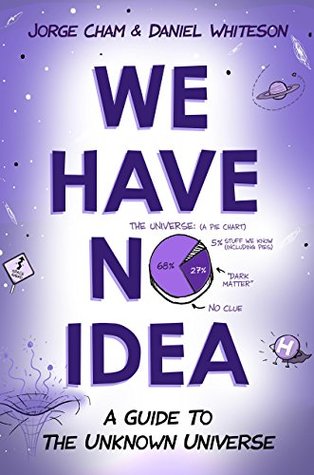More on this book
Community
Kindle Notes & Highlights
by
Jorge Cham
Read between
January 1, 2023 - February 18, 2024
The rest of the universe is mostly dotted with galaxies; there’s no evidence that there are lone stars floating between galaxies. This is fairly new information; as recently as one hundred years ago, astronomers thought that stars were sprinkled evenly throughout space. They had no idea that stars clustered together into galaxies until they built powerful-enough telescopes to notice what those blurry distant objects actually were.
Fairly recently we learned that the galaxies themselves are not distributed evenly throughout the universe. They tend to clump together into loose groups106 and clusters, which themselves group together into massive superclusters, each with dozens of clusters. Our supercluster weighs in at about 1015 times the mass of our Sun. Heavy stuff. So far, up to the scale of galactic superclusters, the structure of the universe is very hierarchical: moons orbit planets, planets orbit stars, stars orbit the center of galaxies, galaxies move around the center of their clusters, and the clusters zoom
...more
One thing is clear: compared to these scales, we are pretty insignificant. We have no special location in the universe; our cosmic address isn’t some central place of great importance, like the cosmic equivalent of Manhattan.107 And in a universe with many billions of galaxies, each with 100 billion stars, it remains to be seen if we are even that unusual when it comes to life and intelligence.
It turns out physicists have a pretty good story for how we ended up in a nonbland universe full of structure. Here’s the theory: small quantum fluctuations in the early universe were stretched by the rapid expansion of space-time (i.e., inflation) into huge enormous wrinkles that seeded the formation of stars and galaxies by gravity, which was aided by dark matter; and at some point in there, dark energy started stretching space out even farther.
Recall that we have a baby picture of the universe from the cosmic microwave background, which shows us what the universe looked like the moment it cooled from a hot, charged plasma to mostly neutral gas. In that image, we see that the universe was smooth but not perfectly smooth. It has tiny ripples that represent the quantum fluctuations of the early universe. During the Big Bang, inflation stretched space tremendously and blew up those tiny ripples into huge wrinkles in the fabric of space and time. These wrinkles in space-time then created the clumps and hot spots of gravity that later led
...more
Physicists suspect that the reason that there are no structures bigger than the sheets and bubbles of superclusters is that there just hasn’t been enough time for gravity to pull things together and form more structure.
If dark energy was not expanding the universe, then gravity would keep doing its job of clumping things together and making ever-larger shapes and structure. But dark energy can’t be denied. So we have two competing effects: having enough time for gravity to clump things into massive shapes but not so much time that dark energy has pulled them apart. At the moment, these two effects seem to be perfectly balanced, which means we live in the perfect age to see the largest structures the universe will ever know.
It seems like we live in a special moment given our current understanding. But the truth is that we don’t know for sure because we can’t confidently predict the future of dark energy. If it continues pulling the universe apart, then there won’t be time for galaxies and superclusters to pull together into more interesting structures. But if dark energy changes course, then gravity has a chance to pull things together and form new kinds of structures that we don’t even have names for yet! Check back in 5 billion years for an update.
So the fact that we have any structure at all—rather than perfect smoothness—is due to the quantum fluctuations that created the first wrinkles, which were then blown out of proportion by inflation, creating the seeds that led to our current universe. But how do those seeds turn into the planets, stars, and galaxies that we see? The answer is a balancing act between two powerful effects: gravity and pressure. Around 400,000 years after the Big Bang, the universe was a big blob of hot, neutral gas with a few little wrinkles in it. That’s when gravity started to do its thing. The fact that
...more


